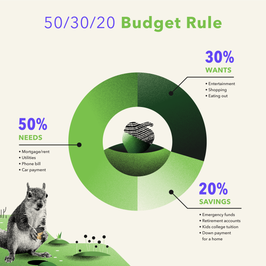What is a Budget?

If you’ve ever found yourself in the unfortunate position of having too much month left at the end of your money, you’re not alone.
According to one recent survey conducted by ING, as many as 56 percent of Americans find themselves running out of money at the end of their pay period either occasionally or most of the time. Other research shows us that up to 78 percent of Americans are living paycheck to paycheck, and that the majority of Americans would be unable to cover an unexpected $1,000 emergency expense if it were to crop up.
While many factors likely contribute to these financial woes, creating a budget (and sticking to it) is one proven way to get a handle on your finances. And yet, only 41 percent of American households follow a budget, according to U.S. Bank.
Wondering what role a personal budget might be able to play in helping you get your finances back on track? Here we explore what a budget is, examine different types of common budgeting strategies, and offer simple steps that you can use to create your own personal budget.
What Is a Personal Budget?
A personal budget is simply a plan for how you will spend your money during a specified period of time—commonly one week or one month. A budget starts with your income, from which you then subtract your expected expenses. Depending on your particular budgeting strategy, you might list out each expense line by line, or you might choose to group them into broader categories to offer some flexibility.
Why Is a Budget Necessary?
A personal budget is an incredibly helpful tool for a number of reasons.
For starters, creating a budget requires you to confront your spending habits in order to identify where your money is going. While this can be uncomfortable for some of us, it can also be an eye-opening experience. If you don’t know where your money is going, it can be very difficult to make any progress towards your financial plans—whether you want to cut down on your spending, save for retirement, pay down debt, or something else.
Beyond this, a budget offers you a quick snapshot of your financial health. For example, if you create a budget and find that you have money left over after all of your expenses have been covered, that means you are living below your means, which presents some money that you can put to use elsewhere (such as savings, investing, or paying down debt). If your expenses use all of the money you’ve allotted, then you’re living within your means. And if your expenses are greater than the money you’ve allotted, then you’re living above your means and should find a way to cut back, or else you may find yourself relying on incurring debt to get by.
The fact is that a budget helps you to plan. By listing out your expenses for the week or for the month and understanding how much money you have left over, you will be better able to identify a cash flow problem ahead of time, which can help you avoid turning to debt like credit cards to cover your expenses.
Types of Personal Budgets
At its heart, every budget is simply a document that subtracts your expected expenses from your expected income. But there are actually many different budgeting strategies that you can use to track your spending and plan how you will use your money.
The budgeting strategy that’s right for you will depend on your own personal financial goals. There is no right or wrong answer. Below are some of the most popular types of personal budgets that you might consider choosing from.
1. 50/30/20 Budget
To follow the 50/30/20 rule, you will take your net income (your take-home pay after taxes and other payroll deductions) and divide it into three categories: 50 percent to your needs (things like rent, utilities, debt payments, food); 30 percent for your wants (things like entertainment, eating out, and clothing), and 20 percent for your savings (like saving for retirement, emergencies, and other goals).
This type of budget is popular with those who are new to budgeting, and for good reason: It’s one of the simplest budgets to set up and follow. It offers structure to guide your spending, but also gives you the flexibility and freedom to indulge every once in a while so long as you still fall within the appropriate expense ranges.
2. Envelope Budgeting
The envelope budget involves splitting out your expenses into different expense categories and designating a specific amount of money that you can spend on each category.
For each category (for instance, groceries, entertainment, etc.), you will carry a physical envelope, which you will fill with a predetermined amount of cash and bring with you when you plan on using that pool of money. Once you’ve spent all of the money designated to a specific category, that’s it—you’re done. If you finish the month with cash left over in an envelope, it’s typically recommended that you use it to bolster your savings or pay down your debt.
Envelope budgeting is often used by individuals who are trying to rein in their spending, for a number of reasons. Strict limits for individual categories make it easy to know exactly where your money is going. Paired with the psychological effects of spending physical money (and, in this case, watching your pool of available funds dwindle over the course of a month), it can help you make better decisions about how you spend your money.
3. Zero-Based Budgeting
Zero-based budgeting involves taking your monthly income and deliberately assigning every dollar a task to perform: paying for food and groceries, covering your utilities, contributing to savings, etc. The goal is to have a balance of zero dollars at all times.
By giving every dollar a specific job to do, zero-based budgeting makes tracking your spending pretty easy, which can help curb overspending. It can also be effective for those who find that they have very little wiggle room in their budgets, because it helps you make every dollar count.
4. Pay Yourself First Budgeting
The "pay yourself first" budget method is exactly what it sounds like: Each month, you decide what percentage of your income you want to designate to saving or other financial goals, and you immediately transfer that money out of your checking account. You can spend the rest of your money however you wish, so long as you meet your obligations.
Because this budgeting strategy prioritizes your financial goals over all other expenses, “pay yourself first” budgeting can work for those who have struggled to save enough in the past, as well as those who have particularly ambitious financial goals.
How to Get Started
If you’re thinking about creating your first personal budget, it is natural that you might feel overwhelmed; after all, there is a lot to consider. But the important thing is to simply get started. Though your first budget might not be perfect, it is just your first step towards achieving your financial goals.
With this in mind, here are some tips to help you get started:
Audit your spending
Before you create a budget, you need to understand how you are spending your money. By examining your spending habits (ideally for the past three to six months), you can create a clear picture of exactly where your money is going—information you can use to plan your budget, spot trends, and find ways to cut back.
Split expenses into categories
Once you understand how you have spent your money in the past, it’s important to group each of your purchases into a specific category (housing, utilities, food, entertainment, etc.) This will make it easier to plan out your first budget, and can also help you prioritize certain expenses over others.
Choose a budgeting strategy
Select a budgeting strategy that you believe will help you reach your goals, and start using it.
Take advantage of free tools
There are countless free tools that you can use to start a budget and stay on track. Apps like Wally and Mint can help you track your spending and bills, and there are dozens of free budgeting worksheets and templates available to download across the web (like the ones here, here, and here).
Remember to factor in savings
At a minimum, you budget needs to account for your expenses: in essence, how you will spend your money. Ideally, though, it will also factor in savings and other financial goals.
Revisit and adjust
Remember, a budget should be a living document that you revisit each and every month as your spending habits change and you progress towards your financial goals. Don’t be afraid to adjust your budget as necessary to find something that works for you—even if it means potentially starting from scratch by trying a different budgeting strategy.
When you find a budgeting style that works for you, it will make it easier to stick to it and get yourself on a path to reach your financial goals.
This material has been presented for informational and educational purposes only. The views expressed in the articles above are generalized and may not be appropriate for all investors. The information contained in this article should not be construed as, and may not be used in connection with, an offer to sell, or a solicitation of an offer to buy or hold, an interest in any security or investment product. There is no guarantee that past performance will recur or result in a positive outcome. Carefully consider your financial situation, including investment objective, time horizon, risk tolerance, and fees prior to making any investment decisions. No level of diversification or asset allocation can ensure profits or guarantee against losses. Article contributors are not affiliated with Acorns Advisers, LLC. and do not provide investment advice to Acorns’ clients. Acorns is not engaged in rendering tax, legal or accounting advice. Please consult a qualified professional for this type of service.








